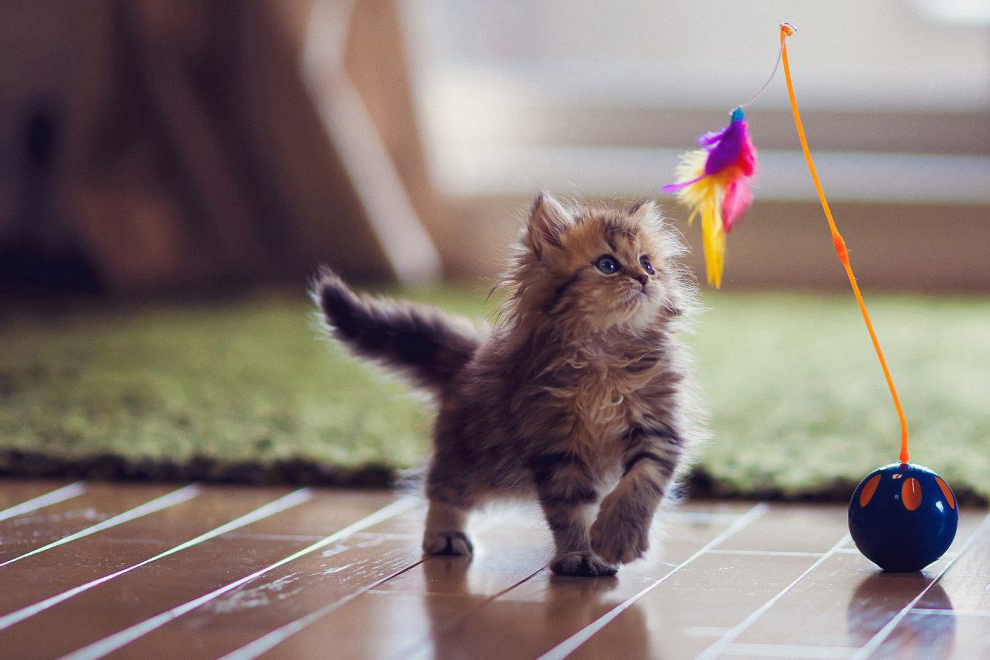Sit… Stay… At Home: Pet-Friendly Quarantine Activities
Social distancing has created a new sense of normal for many of us, including our pets. Dogs are probably excited that we are staying in our slippers all day, while some cats may be less than enthusiastic that we’re disturbing their outrageously long naps.

Though social distancing presents some benefits, many may be finding the abundance of free time to be challenging. Courtney Markley, a veterinary student ambassador at the Texas A&M College of Veterinary Medicine & Biomedical Sciences, offers some ideas to change up the monotony of the day.
“Pet owners can introduce new activities in their normal daily schedule to help pets adjust to all of these changes,” Markley said. “Pets will still expect an early breakfast and may need time to relax alone, either in their crate or a room by themselves, if they’re not used to constant excitement during the day.”
When your pets are ready to come out and play, Markley recommends some shelter-in-place-friendly activities that can occupy both pet and owner.
“Owners of a feisty feline probably already know cats frequently enjoy the package a store-bought toy comes in more than the actual toy, which is great news now that we’re staying home,” she said.
Along these lines, a few budget-friendly ideas to spice up your cat’s day can include:
- Cutting little holes in cardboard toilet paper rolls or adding some fringe along the edges before tossing it on the floor. Kids can even decorate them with non-toxic markers.
- Cutting a cat-sized hole in the side of a box or covering an open box with a T-shirt so that the neck hole creates a “door” to give the cat a place to hide. Cutting multiple holes of various sizes creates opportunities for sneak-attacks during playtime!
- Using laser pointers can be fun for cats to burn some energy. Always give them a treat at the end of the game to make their “hunt” successful. If not, they may become frustrated.
- Tying wine corks (boiled for sanitation) to a string, adding some feathers, or just tossing it to your cat can also make a good toy.
Dogs can get in on the fun, too, Markley says, noting that the free time many people have found in quarantine is perfect to brush up on their training.
“There is a wealth of dog training information available online; positive reinforcement training is a great place to begin your search,” she said.
If the usual activities like fetch, walks, and training begin to get old, Markley recommends trying the following ideas:
- Creating rope/tug toys out of a cut-up T-shirt (or old fleece jacket if you need a stronger toy). Simply cut three strands of fabric of decent length, then tie them in a knot at one end, braid the strands just like you braid hair, and finish it with a knot before play time begins.
- Blowing some bubbles! Dogs enjoy bubbles just as much as kids, so this idea is a double-win.
- Playing a game of hide-and-seek. Either tell the dog to stay and go hide somewhere before calling them, or send the kids to go hide somewhere with a squeaky toy while you help Fido count to 10. Once everyone is in position, call your dog’s name or squeak the toy to help them find you.
- Practicing “nose work.” Put a few treats in a muffin tin and cover them with tennis balls. Dogs will have to use their noses to determine which tennis balls are covering treats and then figure out how to remove the tennis ball.
- Offering self-entertainment. Some toys can be filled with store-bought treats or snacks from the fridge if your pooch needs to entertain themselves for a while. Freezing the toy before you give it to them can increase the time it takes to get all of the snacks out.
When filling toys with treats, it is important to stay away from toxic foods like raisins and other dried fruits, onions, garlic, chocolate, fatty foods, and foods that contain an artificial sweetener called Xylitol, which is sometimes found in peanut butter.
“Fruits and veggies make great snacks for dogs and even your cat, if they’re an adventurous eater,” Markley said. “My go-to treat recipe includes peanut butter or nonfat plain yogurt, kibble, and a fruit like frozen blueberries or bananas.”
If you choose to give some extra snacks, especially peanut butter, remember to decrease the amount of kibble your pet receives for breakfast or dinner, so they don’t consume extra calories.
When making homemade toys, Markley points out a few potential hazards pet owners should avoid.
“Some dogs love water bottles, but the cap and any plastic pieces they chew up can become choking hazards, so stay away from those,” she said. “When making toys for cats, be careful using string because they might try to eat that, too.”
Quarantine has many of us chasing our own tails. Though current circumstances may be stressful, pet owners can use this time to reconnect with their furry friends and make the best of their time at home.
Pet Talk is a service of the College of Veterinary Medicine & Biomedical Sciences, Texas A&M University. Stories can be viewed on the web at vetmed.tamu.edu/news/pet-talk. Suggestions for future topics may be directed to editor@cvm.tamu.edu.


